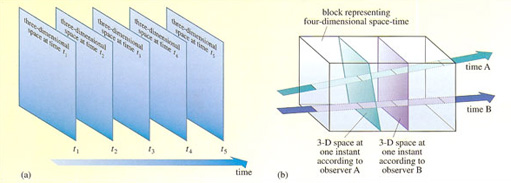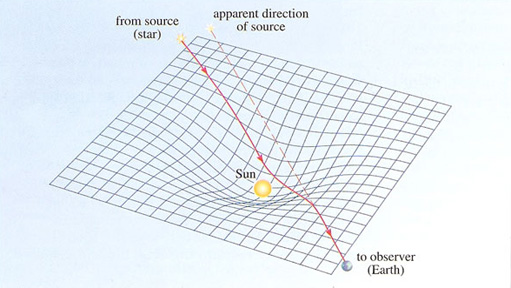2.4.2 Relativity, space, time and gravity
Throughout the development of mechanics and electromagnetism the role of space and time had been clear and simple. Space and time were simply the arena within which the drama of physics was played out. Speaking metaphorically, the principal 'actors' were matter and ether/fields; space and time provided the setting but didn't get involved in the action. All that changed with the advent of the theory of relativity.
The theory was developed in two parts. The first part is called the special theory of relativity, or, occasionally, the restricted theory, and was introduced in 1905. The second part is called the general theory, and dates from about 1916. Both parts were devised by the same man, Albert Einstein.
The origins of the special theory of relativity can be traced back a long way. In 1632, Galileo wrote:
'Shut yourself up with some friend in the main cabin below decks on some large ship, and have with you there some flies, butterflies and other small flying animals. Have a large bowl of water with some fish in it: hang up a bottle that empties drop by drop into a wide vessel beneath it. With the ship standing still, observe carefully how the little animals fly with equal speed to all sides of the cabin. The fish swim indifferently in all directions; the drop falls into the vessel beneath; and, in throwing something to your friend, you need throw no more strongly in one direction than another, the distances being equal; jumping with your feet together, you pass equal spaces in every direction. When you have observed all these things carefully (though there is no doubt that when the ship is standing still everything must happen in this way), have the ship proceed with any speed you like, so long as the motion is uniform and not fluctuating this way and that. You will discover not the least change in all the effects named, nor could you tell from any of them whether the ship was moving or standing still."
Galileo Galilei (1632), Dialogue Concerning the Two Chief Systems of the World.
In other words, any phenomenon you care to study occurs in just the same way in a steadily moving ship as in a stationary ship. The underlying physical laws and fundamental constants must therefore be exactly the same for all uniformly moving (or stationary) observers. This fact, which dozing train passengers may accept with gratitude, is the central idea of the theory of special relativity. Indeed, it is called the principle of relativity. This leaves one obvious question: how did Einstein gain both fame and notoriety for promoting an idea that was nearly three hundred years old?
The answer is that a lot of physics had been discovered between the time of Galileo and that of Einstein. Most notably Maxwell's theory of electromagnetism had achieved the feat of predicting the speed of light using fundamental constants of electromagnetism, constants that could be measured using simple laboratory equipment such as batteries, coils and meters. Now, if the principle of relativity were extended to cover Maxwell's theory, the fundamental constants of electromagnetism would be the same for all uniformly moving observers and a very strange conclusion would follow: all uniformly moving observers would measure the same speed of light. Someone running towards a torch would measure the same speed of light as someone running away from the torch. Who would give credence to such a possibility?
Einstein had the courage, self-confidence and determination to reassert the principle of relativity and accept the consequences. He realised that, if the speed of light were to remain the same for all uniformly moving observers, space and time would have to have unexpected properties, leading to a number of startling conclusions, including the following:
Moving clocks run slow. If I move steadily past you, you will find that my wristwatch is ticking slower than yours. Our biological clocks are also ticking, and you will also find that I am ageing less rapidly than you.
Moving rods contract. If an observer on a platform measures the length of a passing railway carriage, he or she will measure a shorter length than that measured by a passenger who is sitting inside the carriage.
Simultaneity is relative. Suppose you find two bells in different church towers striking at exactly the same time (i.e. simultaneously). If I move steadily past you, I will find that they strike at different times (i.e. not simultaneously). It is even possible for you to find that some event A happens before some other event B and for me to find that they occur in the opposite order.
The speed of light in a vacuum is a fundamental speed limit. It is impossible to accelerate any material object up to this speed.
If these consequences seem absurd, please suspend your disbelief. It took the genius of Einstein to realise that there was nothing illogical or contradictory in these statements, but that they describe the world as it is. Admittedly we don't notice these effects in everyday life but that is because we move slowly: relativistic effects only become significant at speeds comparable with the speed of light (2.998 × 108 metres per second). But not everything moves slowly. The electrons in the tube of a TV set are one example, found in most homes, where relativistic effects are significant.
One of the first people to embrace Einstein's ideas was his former teacher, Hermann Minkowski (1864-1909). He realised that although different observers experience the same events, they will describe them differently because they disagree about the nature of space and the nature of time. On the other hand, space and time taken together form a more robust entity:
'Henceforth space by itself, and time by itself, are doomed to fade away into mere shadows, and only a kind of union of the two will preserve an independent reality.'
Hermann Minkowski, Space and Time in A. Einstein et al. (1952), The Principle of Relativity, New York, Dover Publications.
The union of space and time of which Minkowski spoke is now generally referred to as space-time. It represents a kind of melding together of space and time, and since space is three-dimensional, and time is one-dimensional, space-time is four-dimensional. Any particular observer, such as you or I, will divide space-time into space and time, but the way in which that division is made may differ from one observer to another and will crucially depend on the relative motion of the observers.
A very rough attempt at representing diagrammatically this change of attitude towards space and time is shown in Figure 25. Before Einstein introduced special relativity, the phrase 'the whole of space at a particular time' was thought to have exactly the same meaning for all observers. After Einstein's work it was felt that each observer would understand what the phrase meant, but that different observers would disagree about what constituted the whole of space at a particular time. All observers would agree on what constituted space-time, but the way in which it was sliced up into space and time would differ from one observer to another, depending on their relative motion. No observer had the true view; they were all equally valid even though they might be different.

In retrospect, special relativity can be seen as part of a gradual process in which the laws of physics attained universal significance. The earliest attempts to understand the physical world placed Man and the Earth firmly at the centre of creation. Certain laws applied on Earth, but different laws applied in the heavens. Copernicus overturned this Earth-centred view and Newton proposed laws that claimed to apply at all places, and at all times. Special relativity continues this process by insisting that physical laws should not depend on the observer's state of motion - at least so long as that motion is uniform. It is therefore not surprising that Einstein was led to ask if physical laws could be expressed in the same way for all observers, even those who were moving non-uniformly. This was the aim of his general theory of relativity.
Einstein realised that many of the effects of non-uniform motion are similar to the effects of gravity. (Perhaps you have experienced the sensation of feeling heavier in a lift that is accelerating upwards.) With unerring instinct he treated this as a vital clue: any theory of general relativity would also have to be a theory of gravity. After more than ten years of struggle, the new theory was ready. According to general relativity, a large concentration of mass, such as the Earth, significantly distorts space-time in its vicinity. Bodies moving through a region of distorted space-time move differently from the way they would have moved in an undistorted space-time.
For example, meteors coming close to the Earth are attracted to it and deviate from uniform, steady motion in a straight line. Newton would have had no hesitation in saying that these deviations are due to gravitational forces. In Einstein's view, however, there is no force. The meteors move in the simplest way imaginable, but through a distorted space-time, and it is this distortion, generated by the presence of the Earth, that provides the attraction. This is the essence of general relativity, though the mathematics required to spell it out properly is quite formidable, even for a physicist.
The central ideas of general relativity have been neatly summarised by the American physicist John Archibald Wheeler. In a now famous phrase Wheeler said:
'Matter tells space how to curve.
Space tells matter how to move.'
Purists might quibble over whether Wheeler should have said 'space-time' rather than 'space', but as a two-line summary of general relativity this is hard to beat (see Figure 26). If you tried to summarise Newtonian gravitation in the same way all you could say is: 'Matter tells matter how to move'; the contrast is clear.

General relativity is a field theory of gravity. At its heart are a set of equations called the Einstein field equations. To this extent general relativity is similar to Maxwell's field theory of electromagnetism. But general relativity is a very unusual field theory. Whereas electric and magnetic fields exist in space and time, the gravitational field essentially is space and time. Einstein was well aware of the contrast between gravity and electromagnetism, and spent a good deal of the later part of his life trying to formulate a unified field theory in which gravity and electromagnetism would be combined into a single 'geometric' field theory. In this quest he was ultimately unsuccessful, but general relativity remains a monumental achievement.
Question 5
Would it be fair to say that special relativity has the effect of leaving each observer completely free to make his or her own decision about what constitutes time?
Answer
According to special relativity, different observers disagree about how to slice space-time up into space and time. But observers are not free to make arbitrary choices. All observers must find that light travels at a constant speed of c = 2.998 × 108 metres per second, and this will not be possible if an observer uses a clock that is running slower and slower, for example. The definition of time is made quite naturally in special relativity as the time ticked on a regularly running clock that travels with the observer.
